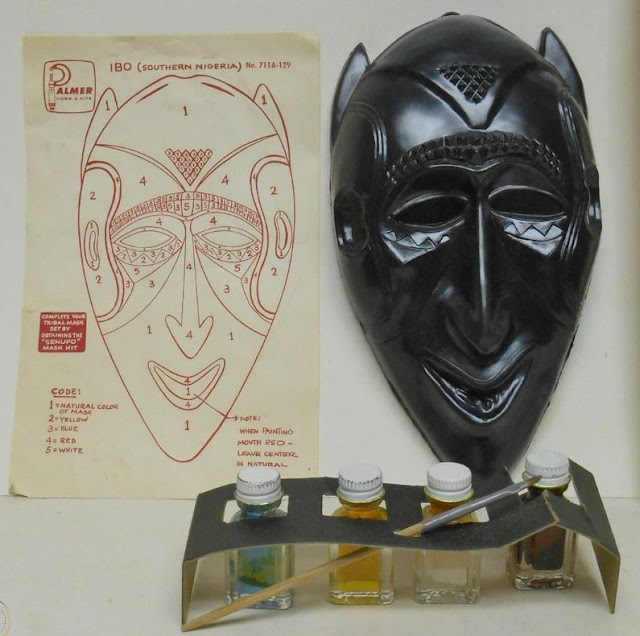In the 1950s kit makers were trying to find new subjects for models, beyond the usual aircraft, cars, and ships. Eventually military vehicles, large scale figures, and space models would become well established, mainstream subjects.
But along the way, some firms produced a number of truly bizarre items, with which they tried to tempt modellers. Many of these came from the smaller kit companies, looking to break in to the big time.
Palmer Plastics Inc, of Brooklyn, New York, was one of these smaller American kit companies. They mostly produced car kits, but also ventured out in to other subjects.
Among these were a pair of Authentic African Tribal Masks. Actually, it seems these were not kits, but single-piece mouldings.
Both were released as Paint by Number sets. Included were the moulded plastic mask; paints; brush; illustrated color guide; and mounting hook.
The colour guide was a sheet of paper, with a nearly full size drawing of the mask. Just like a normal paint-by-numbers painting this was divided in to numbered sections. Each number being a different colour. There were four glass jars of paint, held in a cardboard strip across the bottom of the box, and a brush. Once the mask had been painted to match the drawing, it could be hung on a wall.
The mounting hook mentioned on the box seems to be the thin plastic hoop between the horns. The box lid suggests suitable places for the finished mask 'Hang in your playroom - bedroom - den - living room'.
The catalogue number given on Scalemates is incorrect. It does indeed look like 7118, but the two sets are actually numbered 711A and 711B. The suffix to the number, -129, means that these sets sold for $1.29 in the US when they were released.
This old ad from a hobby industry magazine is dated September 1959, and describes the sets as 'New'. It shows both masks in full colour, giving a great deal of information on them. This includes the fact that they were shipped to retailers in cartons of 24 assorted sets, or 22 sets and two ready-painted display masks in a special, full-colour store display.
Palmer Plastics Hobb-E-Kits Authentic African Tribal Mask
711B-129 Senufo (Ivory Coast) - Rigid Molded Plastic 10" x 5 1/2"
The mask was moulded in black, and this was used as one of the colours, along with yellow, blue, red, and white. In one corner of the painting guide it says 'Complete your tribal mask set by obtaining the "Ibo" mask kit'. That seems to indicate that there were only two different masks in the series.
This is the only mask listed on Scalemates, which gives a release date of 1958 rather than 1959.
711A-129 Ibo (Southern Nigeria) - Rigid Molded Plastic 9" x 5"
Again the mask is moulded in black plastic, and the paint colours are the same in both sets.
These sets are certainly not run of the mill. There are very few sales listings for them, and I doubt many were sold at the time. I could not find any sign that they have ever been re-issued.
Three photographs form Worthpoint
Paul Adams from New Zealand





Love these model vintage masks. Not seen anything like them before.
ReplyDeleteNothing like them today.
ReplyDeleteWhen I first saw these masks, I could not believe they existed. They just seem so bizarre. But on reflection, they make a little more sense.
ReplyDeleteIn the 1950s there was a trend, at least in the USA, towards exotic South Seas art and design. Known as Tiki art. I am sure much of it was a mish-mash of different cultures, and different periods. Perhaps Palmer thought a set of Masks from the even more distant and exotic world of Africa would be a sure-fire seller ?
Given how rare these sets are today, it seems they were not the hit Palmer were hoping for.
The Flickr feed with the magazine ad is from the late Andy Yanchus, one of the foremost experts on space toys and kits of recent times. Well worth a look at some of the amazing entries he had on there. Bill
ReplyDeleteDavid Attenboroughs early TV series 'Tribal Eye' discusses the influence of African tribal art on the development of European abstract and cubist art, with Barque and Picasso being early adopters of the style. Tribal imagery was also very popular as an interior decoration in the late fifties and sixties in Europe.
ReplyDeletehttps://www.youtube.com/watch?v=Uz96thYaD0c Bill
Extraordinary! Nothing remotely like that could be marketed today! What a wonderful lost world it was ...
ReplyDelete